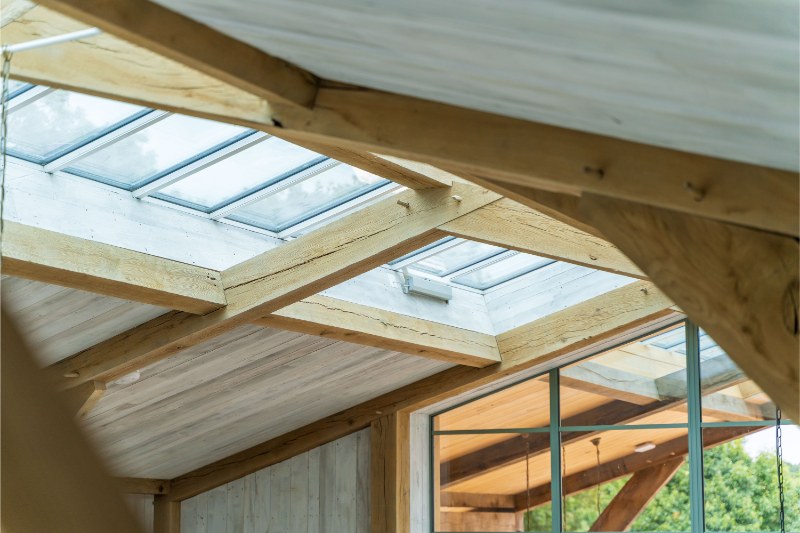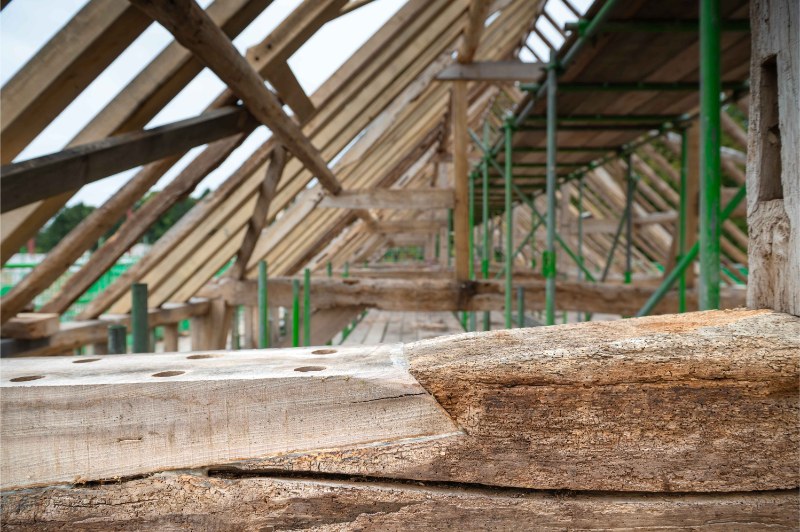Green oak is a term often heard in construction and woodworking circles, but what does it actually mean? Simply put, green oak is oak timber that has been freshly cut and has not yet been seasoned or dried. Unlike seasoned or kiln-dried oak, green oak contains a high moisture content, often ranging between 60-80%, depending on how recently it was felled.
The term “green” doesn’t refer to the colour of the wood; rather, it indicates the freshness of the timber and its high water content. Because of this moisture, green oak is relatively soft and workable, making it easier to cut, shape, and join using hand tools or machinery. Over time, as green oak naturally dries, it shrinks, splits, and moves.
Historically, green oak has played a significant role in British construction. From medieval barns and houses to oak bridges, quays, and even communal halls, green oak has been valued for its strength, versatility, and longevity. Today, it remains a popular choice for oak frame houses, conservatories, orangeries, and outdoor structures.
But how does green oak compare to other types of oak like seasoned or kiln-dried oak? Let’s break that down.

The Difference Between Green Oak and Seasoned Oak
When it comes to building with timber, knowing the difference between green oak and seasoned oak is important. Using the right type of oak can affect everything from how your structure settles and moves over time to how easy it is to work with.
Drying and Moisture Content
Green oak is freshly cut and unseasoned, containing high levels of moisture. Whereas seasoned oak has been carefully dried, naturally or in kilns, reducing moisture content to around 12-15%. This makes it more stable and less prone to movement.
Movement and Shrinkage
Green oak shrinks, twists, and splits as it dries. This can affect dimensions and needs careful planning in construction. Seasoned oak has largely completed its drying process, so it experiences minimal movement, making it ideal for precise applications like window frames or glazed structures.
Strength and Workability
While green oak is strong, its softness makes it easier to work with, especially for hand tools and complex joinery. Seasoned oak is generally harder and more durable in the long term but requires more effort and sometimes specialised tools to shape and cut.
Appearance
Green oak has a fresh, golden-brown to pale yellow tone. As it weathers, it develops a beautiful silver-grey patina. Its grain is often more pronounced due to the moisture content. Whilst seasoned oak appears slightly darker and more consistent in colour, with less pronounced grain movement.
Suitability for Different Builds
Green oak is excellent for structural elements, large timber frames, beams, trusses, and exterior work where movement can be accounted for. Seasoned oak is preferred for applications requiring stability, such as glazed conservatories, orangeries, and detailed joinery.
The main difference between green oak and seasoned oak lies in their purpose, green oak offers flexibility and natural beauty during construction, while seasoned oak provides precision and stability for finished structures. Builders often use green oak for large structural frameworks, allowing it to season in place, whereas seasoned oak is preferred for detailed, dimension-critical components.

The Benefits of Green Oak for Construction
Green oak is not only historically significant, it offers modern builders a wide range of advantages such as:
Sustainability
Green oak is a naturally renewable resource, and when sourced responsibly, it supports sustainable building practices. Choosing green oak not only reduces your project’s environmental footprint but also helps promote the replanting and preservation of native hardwood forests.
Strength That Lasts Generations
Few materials can match the mechanical strength of green oak. Its ability to carry heavy loads makes it ideal for beams, trusses, and posts. Over time, the timber hardens, meaning your structure only gets sturdier with age. Many green oak constructions have lasted centuries, proving that this isn’t just strong wood, it’s a legacy material.
Flexibility
Despite its strength, green oak is surprisingly easy to work with. Its softer, fresher structure allows for clean cuts and intricate carvings, whether using hand tools or modern machinery. This makes it perfect for bespoke joinery, custom timber frames, and detailed craftsmanship that would be much harder with fully seasoned oak.
Cost-Effective
Green oak is often more affordable than seasoned or kiln-dried oak because it skips lengthy drying processes. Large structural sections that would take years to season are available immediately, meaning projects can start sooner without inflating costs.
Striking Aesthetic
From its golden-brown fresh-cut glow to the rich silver-grey patina it develops outdoors, green oak brings a natural beauty that evolves over time. Each knot, grain pattern, and slight imperfection adds character, ensuring no two beams or frames are ever the same.
Naturally Resilient
Green oak is built to withstand the elements. Its density and high tannin content make it resistant to moisture, decay, and pests. From exterior cladding to garden structures, it’s a timber that performs beautifully outdoors without needing chemical treatments.
Low Maintenance
One of the biggest advantages of green oak is how little effort it takes to keep it looking great. With just occasional cleaning and minor upkeep, your timber structure will remain strong and visually striking for decades.
For more tips, see our Guide to Maintaining Your Oak Frame here.

Common Green Oak Applications
Green oak is extremely versatile and is used across a wide range of building and woodworking projects. Its strength, beauty, and workability make it suitable for both structural and decorative purposes:
- Green oak frame houses
- Green oak frame conservatories & orangeries
- Beams, trusses, and roof structures
- Green oak garages, pergolas, and outdoor structures
- Cladding and exterior boards
- Interior features ie mantelpieces, stairs, and exposed beams
- Tables, benches, chairs, and bespoke joinery
Green oak’s applications extend beyond these traditional uses, with creative builders continuously finding new ways to integrate this beautiful timber into modern construction projects.

The Final Say
Green oak is still one of the best choices if you want something strong, sustainable, and full of character. With its mix of history and modern craftsmanship, it’s perfect for oak framed extensions and outbuildings.
Whether it’s a frame house, a custom conservatory, or garden structures like garages and pergolas, green oak gives you strength, charm, and timeless appeal. When sourced responsibly, it creates spaces that are both durable and full of personality.
Green oak isn’t just timber, it’s a living material that grows with your home, aging gracefully while lasting for generations. If you want sustainable, high-quality, and genuinely beautiful timber, green oak is the obvious choice.
Ready to bring green oak into your home or project? Speak with our expert team about your next build today.

